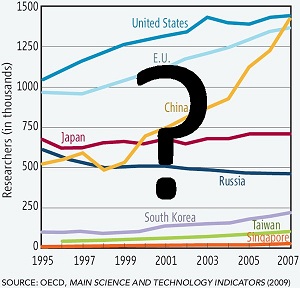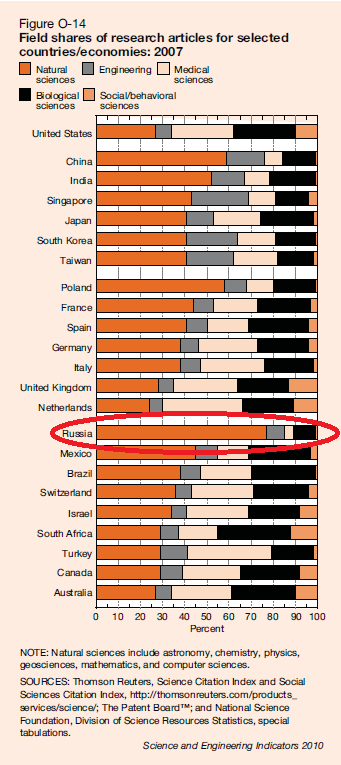In the wake of rating compilers - 2

This picture (without question mark, of course) was given in the topic " Viva China: (Russia) " with reference to the National Science Board . The link is a voluminous report entitled "Science and Engineering Indicators 2010". The subject of the report is mainly education in the USA itself. And the notorious schedule is given in the introductory part of the report.
If you open the Excels and individual PDF files application, which contains the initial data on the report, you can easily make sure that there are no data on the introductory part. The diagram itself says the following:
')
Development & Development, Main Science and Technology Indicators (2009/1 and previous years)
Here is the site of this organization. This report is not freely available. Access to databases only by subscription.
So, the source data is not freely available.
We go to the website of the Federal State Statistics Service (http://www.gks.ru) and find the Russian statistical yearbook 2008 there . See section 21.5. NUMBER OF PERSONNEL EMPLOYED TO RESEARCH AND DEVELOPMENT and see the table:
| 1995 | 2000 | 2001 | 2002 | 2003 | 2004 | 2005 | 2006 | 2007 | |
| Number of staff - total | 1061044 | 887729 | 885568 | 870878 | 858470 | 839338 | 813207 | 807066 | 801135 |
| including: | |||||||||
| the researchers | 518690 | 425954 | 422176 | 414676 | 409775 | 401425 | 391121 | 388939 | 392849 |
| technology | 101371 | 75184 | 75416 | 74599 | 71729 | 69963 | 65982 | 66031 | 64569 |
| support staff | 274925 | 240506 | 238933 | 232636 | 229214 | 223356 | 215555 | 213579 | 208052 |
| other staff | 166058 | 146085 | 149043 | 148967 | 147752 | 144594 | 140549 | 138517 | 135665 |
The number of personnel employed in the field of R & D for 2007 is 800 thousand people or 0.56% of the population. In the NSB article - a little less than 500 thousand. Where did this figure come from? Riddle. Considering that there are practically no private research organizations in Russia, I see no reason not to trust official statistics.
Here it should be noted that there is a division in the table for researchers, technicians, support staff and other personnel. If we count only researchers, then there are about 400 thousand of them in Russia, or 0.28% of the population. From which ceiling in the report the number "500" is still a mystery. On the other hand, the report does not explicitly say anywhere whether the equipment and maintenance personnel are included in the number of researchers or not.
However, one conclusion can already be made: the figures in the report were taken from the ceiling . Is it possible to believe the figures for other countries - an open question.
We now calculate the percentage of researchers in other countries. If you believe this diagram in terms of the number of scientific workers not in Russia , then in the United States, there are 1.4 million researchers, or 0.45%, for 308 million people; in China - 1.3 billion people - 1.4 million researchers or 0.1%; in Japan, 127 million population of 700 thousand researchers or 0.55%; in the European Union, with a population of 500 million, 1.4 million researchers, or 0.28%.
Nothing particularly scary for Russia, it seems, is not observed. The number of researchers in Russia is very high.
Now let's talk about the dynamics of the indicator. First, I would like to note the following: there is nothing surprising in the sharp increase in the number of researchers in Asia, if we recalculate the figures as a percentage of the population. China in relative numbers still lags far behind Russia, Europe and the USA - it still has reserves for growth. Apparently, the figure of 0.5% today represents the limit beyond which growth stops, which is clearly seen in the graphs for Russia, Japan and the United States.
Now let's talk about the dynamics of the number of researchers in Russia. From 1995 to 2007, the number of people employed in R & D was reduced by 260 thousand people or 24.5%. This, of course, is a lot - which is not surprising, given the scale of the geopolitical catastrophe that occurred in the 90s of the last century.
However, if in 1995-2000 the reduction was 174 thousand people, then in the period 2000-2005 - only 48 thousand. And in 2007 there was an increase in the number of researchers by 4 thousand people. It should be borne in mind that these processes took place against the background of a catastrophic depopulation, which, as from 2005, has finally begun to decline.
Unfortunately, I did not find any data for 2008 and 2009, but I can quite confidently assume that there is a slight (several thousand per year) increase in the number of research workers. It is safe to say that the patient is clearly alive and is recovering (the same can be said about demography - in 2009, at last, for the first time in 15 years, population growth has been recorded ).
So I don’t see any reason for panic. On the contrary, the situation with scientific researchers in Russia began to level off, and at the same time Russia, by relative indicators, is in a very, very good position not only in comparison with China, but also with the EU and the USA.
And finally, another timeline from that report. Distribution of research by areas of knowledge (natural sciences - engineering - medical - biological - social):

Feel the difference.
Source: https://habr.com/ru/post/82606/
All Articles